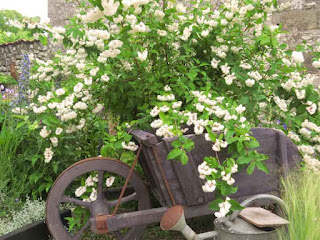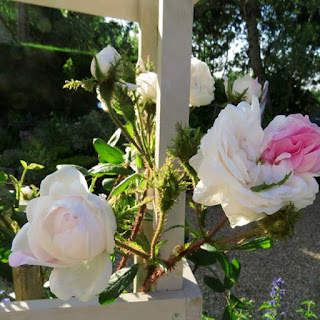"Great things are done by a series
of small things brought together".
- Vincent van Gogh
 |
| June evening on the marais |
It's been said many times that gardening is good for the soul. For that reason it is used as a means of rehabilitation for offenders and as therapy for people who have been emotionally damaged in some way.
 |
| Peony lactiflora with climbing rose 'Scarborough Fair' |
Done properly, gardening breeds in us an empathy for the natural world, for life cycles of blossom and decay and, probably most rewardingly, for combinations of simple, uncontrived beauty.
This is the month for roses, for extravagant peonies and, in the hotter parts of the garden, bright clumps of pink dianthus exuding a subtle scent of cloves.
 |
| Rosa rugosa - 'Rubra' |
In addition to some showy hybrids from David Austin roses, we're also fond of Rosa rugosa - a rough and ready shrub, which thrives in dry areas of semi shade and produces fat red hips after flowering. I normally cut off the first lot of seed heads which form in June, enabling the plant to put its energy into creating more blooms later on.
The flower here has lovely stamens and might be from a hybrid rugosa called 'Rubra' with a particuarly strong scent.
 |
| 'The Pilgrim' rose from David Austin |
However carefully you nurture your roses, you can be sure that Mother Nature will try to trip you up just as they reach a peak of flowering...
Usually it's a sudden storm but this year we went from cool, overcast skies to scorching sun in less than 24 hours. Luckily the forecast had predicted a rise to 34'C, so we prepared most of our plants by watering them well in advance and surrounding them with a well-rotted mulch of leaf mould.
Many of those hybrid roses, such as The Pilgrim (above), produce heavy blooms which soon fade and die if exposed to a lot of rain or sun. So we picked several clusters whilst they were still looking good and brought them into the cool shade of our living room.
Feeding and watering
 |
| Under the shady ash tree |
Fortunately, the high temperatures lasted but a day and we're now back to a stiff northerly breeze, which can be equally drying but a lot less scorching.
We have a shady corner set aside for making compost and leaf-mould - not the most attractive area perhaps but, in addition to housing compost and canes, we've added some shade-loving plants like Lamium maculatum and Geranium 'Kashmir white', which have flourished with the aid of our watering system and make it feel more like a woodland glade.
Another form of nurturing which helps to get the most out of your plants is to use a natural fertilizer to promote flowering. We cut up stems of comfrey, plucked from a nearby meadow, add them to a can of water and leave the rather foul-smelling brew to steep for a couple of weeks.
Metal watering cans are useful for this purpose as long as you cover the openings to keep out mosquitoes.
Depending on how strong the mixture becomes, dilute it with more water before using it around your flowering plants - and take the rose off your watering can otherwise those holes get clogged up with nasty bits of comfrey!
We're always looking at different methods of adding height to our small garden, whether it's with climbing plants, or tall flowers like verbascum and foxglove, or actual structures like this obelisk.
And, when I'm on the computer writing my blog, Christina is always casting around for a new project... so, hey presto, she turned her hand to woodwork and soon came up with this handsome frame for her favourite moss rose.
 |
| Arching stems of Deutzia scabra hang over a French brouette and watering-can |
Metal watering cans are useful for this purpose as long as you cover the openings to keep out mosquitoes.
Depending on how strong the mixture becomes, dilute it with more water before using it around your flowering plants - and take the rose off your watering can otherwise those holes get clogged up with nasty bits of comfrey!
 |
| Christina's obelisk |
Garden structure
And, when I'm on the computer writing my blog, Christina is always casting around for a new project... so, hey presto, she turned her hand to woodwork and soon came up with this handsome frame for her favourite moss rose.
 |
| 'Shailer's White' moss rose - in the pink! |
Much as we love these old-fashioned roses, with their prickly stems and sticky buds, they can be awkward to train neatly without their getting entangled in neighboring plants. (It's interesting how many of our so-called 'white' flowers end up with splashes of pink on their petals..!)
 |
| Caro's 3D birthday card |
Talking of pink - which isn't usually my colour - Christina put together this very artistic card for my birthday. As a miniature vase, she used the small plastic container found in certain hair-colouring products and her little posy actually lasted a whole week. Yes, sometimes the best gifts are ephemeral.
 |
| Young stork being weighed in a bag |
When having coffee in the garden the other day, our neighbour Robert cycled over to tell us that people were coming to ring the baby storks which had been born on his platform earlier this year. Would we like to take some photo's?
I baulked at the idea of climbing up the tall, wavering ladder to photograph the birds in their nest, but it was interesting to observe the 'birdman' who carried out his job of weighing and ringing the chicks with great confidence and dexterity.
 |
| White stork in flight |
This year there were only two juveniles, compared with three or four in previous years; one weighed in at 2k and the other at 4k. Sadly, the body of another baby lay beneath the platform... accident or murder, I wonder?
Whatever the cause, we noted that at least one concerned parent was keeping a close eye on the proceedings, flying in wide circles above us. The other, presumably, was crouched down on the platform with its nestlings.
The whole operation took just minutes and this data will be recorded by the LPO which closely monitors the growing population of storks in our part of France.
 |
| Blue larkspur and Stipa gigantea |
 |
| A fish in the grass! |
Love the Obelisk.
ReplyDelete